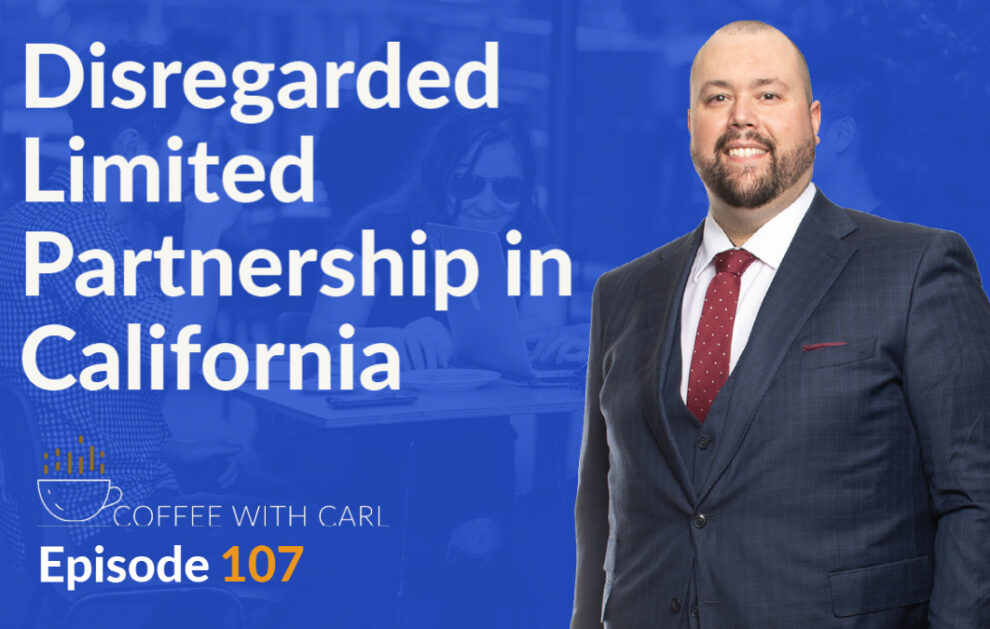When is it advantageous to use a disregarded limited partnership in California?
In this episode of Coffee with Carl, attorney Carl Zoellner guides you through the process of using a disregarded limited partnership.
California dreaming?
That has long passed for the insomniac state, which is why I’m covering California solutions. This should help put some of you at ease.
Let’s get into it.
The California disregarded limited partnership, a mouthful to say… and write, is something interesting to wrap your mind around.
In California, they actually have comments from the Franchise Board that a disregarded limited partnership is not subject to the $800 a year franchise tax, which is strange, to say the least, at this point.
But when working in California, strange is the industry standard.
I don’t think it’s likely to stick around for a long time, but it is currently one of many options out there. So I want to talk a little bit about when it may be appropriate, what you should understand going in, as well as, is it the best solution for you?
Number one
It is an option. Usually, I would say we would look at that as an option for someone who’s doing, I don’t know, several flips a year or has several rental properties they want to use in that scenario simply because it really requires a minimum of three California entities to facilitate appropriately.
Let’s talk a little bit about the setup of a California limited partnership that’s disregarded.
Basically, in order to facilitate this, the ultimate taxpayer has to be the same taxpayer on both the general partner side and the limited partner side. Essentially, if I’m looking at doing a flip, I would have my corporation, if I had a California corporation, set up as the limited partner.
I would have an LLC owned by that corporation to function as the general partner. And then our third entity would be that limited partnership, where that LLC owned by the corporation is the general partner, and the limited partner is directly the corporation. That way, the corporation is technically the taxpayer from the general partner side, as well as the taxpayer from the limited partner side, which then functions like a disregarded entity.
Like I said, it’s California strange, but that’s how you would have it set up if you wanted to take advantage of that disregarded limited partnership.
It’s not my favorite strategy in California just because I don’t think it will be around for that long. California sort of has a long history of stepping around things that don’t have to pay the franchise tax and then all of a sudden making them pay the franchise tax. What I would look at, actually, if I wanted to say future proof myself, is if I’m going in now as new, to look at future proof, I’d probably look at that Wyoming statutory trust.
There’s lots of videos on it, several by Clint Coons with Anderson, and look at that as a sort of a longer term solution for California investing. The trust functions like a business entity in California. It’s set up in Wyoming, so there’s some additional protection there. And California recognizes it, as well. It’s probably the best way to go.
If you’re thinking about moving to Wyoming statutory trusts, what I would look at is, is there a catalyst to do so? Are you still building on? Is there a reason to change your portfolio over to that? If there is, great. Then, yes, I would use the Wyoming statutory trust. If not, there’s nothing wrong with your land trust to the Wyoming LLC scenario, if that’s what you’re using.
I know we do get folks who start getting nervous if there were something we’ve changed or something we now prefer. Like I said, my preference is, if somebody’s starting brand new today or moving forward today, Wyoming statutory trust is a great tool to use. I like it.
However, if you have several properties already in your portfolio with land trusts, with Wyoming as beneficiaries, you’re fine. Unless there’s some sort of catalyst or reason you want to switch over, I don’t know that you’d have to, but what you may do is, moving forward, use Wyoming statutory trusts.
It’s not going to hurt your portfolio, not going to hurt your overall entity structure. But if you do want to move, you can.
Quick Summary
Like I said, it’s a limited-time sort of item to use. Just be aware it’s not appropriate in all aspects. If you’ve only got one or maybe if you’ve got one or two properties in California, it may not make sense because you’re really looking at a minimum of those three business entities in California, basically the tax paying entity, especially if you’re doing something like high-end flips in California.
You’d be looking at your corporation, an LLC owned by your corporation and then a limited partnership that’s owned by the corporation and the LLC owned by the corporation, so that you tick the boxes of the taxpayers the same from both owner’s perspectives, limited and general partner.
I know, a little bit confusing on the disregarded limited partnership. We can help you through it if you need it. If you’re not an Anderson client already, I suggest everybody give us a call and you can get a free consultation.
We’re not going to charge you for the consultation, and we’ll let you know what we think would probably work best in your entity structure.
If you are an Anderson client, chances are you’re a Platinum member. If you’re a Platinum member, you’re always welcome to talk to our professional staff, especially the attorneys who are able to hop on a call with you, usually same day at this point, and we’ll be able to help you through any of your issues.
The Takeaway
As always, keep taking advantage of our free educational opportunities and the free content we put out on the web. So that’s Toby’s Tax Tuesday, our tax and AP events for our clients who’ve already gone through our Tax and Asset Protection event.
Our Structure Implementation Series is fantastic. That answers a lot of the questions you have in the beginning. So there are a lot of different educational opportunities out there. One of my favorites as well is our Infinity Investing Workshop.
Resources mentioned in this video:
- Join our next Tax & Asset Protection event to learn more advanced tax minimization & entity structuring strategies
- Subscribe to our YouTube channel to make sure you never miss the latest strategies & updates
- Check Out Toby’s Video where he mentions PLLC on your business card
Got an idea for a future Coffee with Carl? Send it to Carl at cwc@andersonadvisors.com.
Free Strategy Session with an Anderson Advisor
Receive a detailed risk assessment to assist in lowering problem areas that could wipe out all of your assets with one wrong move. Speak with an Anderson Professional Advisor to get your FREE Strategy Session.
Limited-Time Offer: ($750 value.)











